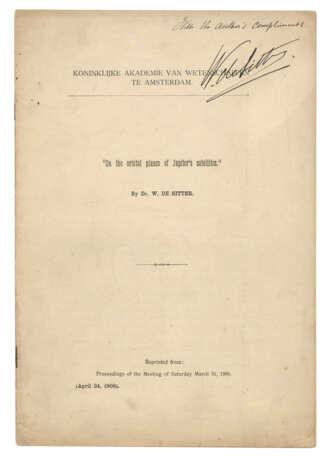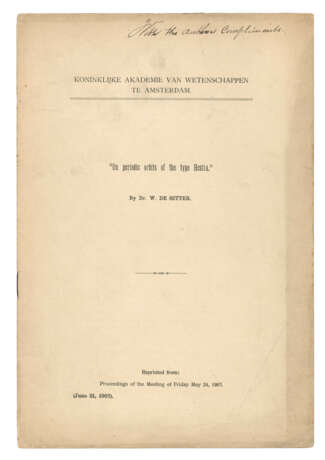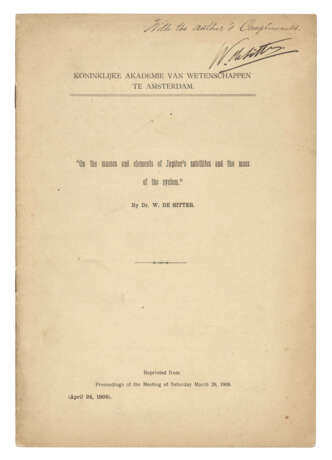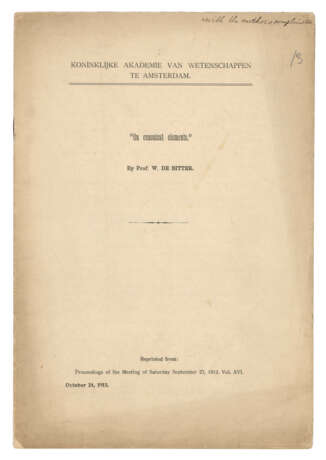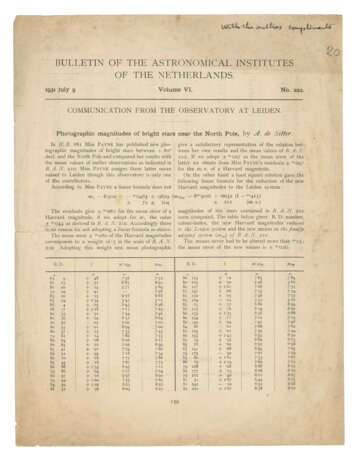ID 1105730
Lot 56 | DE SITTER, Willem (1872-1934)
Valeur estimée
£ 2 000 – 3 000
6 offprints relating to the satellites of Jupiter. Amsterdam: 1905-1909.
An important collection of rare authorial presentation offprints detailing De Sitter’s main contributions to astronomy in the field of celestial mechanics, and establishing the framework by which Einstein’s theory of relativity can be applied to cosmology.
From 1897-1899, De Sitter worked under David Gill at the Royal Observatory in Cape Town, before moving to Groningen, later becoming professor of astronomy at the University of Leiden in 1908; from 1919 De Sitter was also director of the Leiden Observatory. Starting at Cape Town, and later developing his work at Groningen, De Sitter concentrated on observations of the satellites of Jupiter. ‘Satellites of a planet slightly disturb the motions of each other by their mutual attractions, and a study of these perturbations enables the mass of a satellite to be determined with its orbital elements. This problem was one of high mathematical complexity … De Sitter was particularly well prepared for the task’ (DSB). Analysis of photographic observations, coupled with a thorough analysis of the earliest recorded observations by the likes of Galileo, led De Sitter to publish the present lot’s important papers on the subject. It was to intrigue him for another 30 years, culminating in his breakthrough New Mathematical Theory of Jupiter’s Satellites published in 1925.
Einstein’s publication of his theory of relativity led De Sitter to appreciate the theory’s consequences for small deviations on planetary bodies and their satellites, and produced a series of three papers on the subject in 1916-1917, the third of which introduced the concept now know as the ‘De Sitter Universe,’ which uses general relativity to create a simple mathematical model consistent with the observed accelerating expansion of the universe. It was De Sitter’s work and his unique application of Einstein’s theories to astronomy that introduced Einstein’s theories to the English-speaking scientific community. Sold with one of De Sitter's final papers regarding the theory of relativity in relation to an expanding universe, one other related De Sitter offprint, and two others by his son Aernout De Sitter (1905-1944) on star observations.
‘Over de Libratie der drie binnenste groote Satellieten van Jupiter, en eene nieuwe methode ter bepaling van de massa van Satelliet I.’ Offprint from: Handelingen van het Tiende Vlaamsch Natuur- en Geneeskundig Congres, April 1905.
Octavo (246 x 162mm). text in Dutch, bifolium, 4pp., drophead title (sometime folded with fainted creasefolds, these with associated short marginal tears, a couple of other minor nicks and light soiling mainly confined to extremities). Provenance: presentation inscription in secretarial hand at head of first page ‘With the author’s compliments’.
‘On the orbital planes of Jupiter’s satellites’ Offprint from: Proceedings of the Section of Sciences. Amsterdam: Koninklijke Nederlandse Akademie van Wetenschappen, 24 April 1906.
Octavo (260 x 180mm). Pp. 14, 767-780. Original stapled wrappers (faintly soiled at extremities of wrappers, lower corner lightly dogeared). Provenance: authorial inscription with presentation inscriptions in secretarial hand on upper wrapper ‘With the author’s compliments’.
‘On periodic orbits of the type Hestia.’ Offprint from: Proceedings of the Section of Sciences. Amsterdam: Koninklijke Nederlandse Akademie van Wetenschappen, 21 June 1907.
Octavo (260 x 180mm). Pp. 10, 47-56. Original stapled wrappers (faintly soiled at extremities of wrappers, lower corner slightly dogeared). Provenance: presentation inscription in secretarial hand on upper wrapper ‘With the author’s compliments’.
‘On some points in the theory of Jupiter’s satellites.’ Offprint from: Proceedings of the Section of Sciences. Amsterdam: Koninklijke Nederlandse Akademie van Wetenschappen, 3 September 1907.
Octavo (260 x 180mm). Pp. 13, 95-107. Original stapled wrappers (faintly soiled at extremities of wrappers, some folded with light horizontal creasefold). Provenance: presentation inscription in secretarial hand on upper wrapper ‘With the author’s compliments’ – old pencilled price on upper wrapper.
‘On the masses and elements of Jupiter’s satellites and the mass of the system.’ Offprint from: Proceedings of the Section of Sciences. Amsterdam: Koninklijke Nederlandse Akademie van Wetenschappen, 24 April 1908.
2 vols, octavo (260 x 180mm). Pp. 21 and20, 653-673 and 710-729. Original stapled wrappers (faintly soiled at extremities of wrappers, upper corners faintly dogeared). Provenance: authorial inscription with presentation inscriptions in secretarial hand on upper wrappers ‘With the author’s compliments’.
‘On the periodic solutions of a special case of the problem of four bodies.’ Offprint from: Proceedings of the Section of Sciences. Amsterdam: Koninklijke Nederlandse Akademie van Wetenschappen, 25 March 1909.
Octavo (260 x 180mm). Pp. 17, 682-698. Original stapled wrappers (wrappers detached, staining to lower margin just entering text and becoming heavier towards end, extremities lightly creased). Provenance: presentation inscription in secretarial hand on upper wrapper ‘With the author’s compliments’.
‘On canonical elements.’ Offprint from: Proceedings of the Section of Sciences. Amsterdam: Koninklijke Nederlandse Akademie van Wetenschappen, 24 October 1913.
Octavo (260 x 180mm). Pp. 13, 279-291. Original stapled wrappers (some light soiling and creasing). Provenance: presentation inscription in secretarial hand on upper wrapper ‘With the author’s compliments’.
'On the foundations of the theory of relativity, with special reference to the theory of the expanding universe.' Offprint from: Proceedings of the Section of Sciences. Amsterdam: Koninklijke Nederlandse Akademie van Wetenschappen, XXXVII, 9, 1934.
Octavo (260 x 180mm). Pp. 7, 597-601. Original stapled wrappers (some soiling and creasing).
DE SITTER, Aernout (1905-1944). ‘Photographic magnitudes of stars brighter than 7m.5 between declination +80° and the pole.’ Offprint from: Bulletin of the Astronomical Institutes of the Netherlands. Vol. VI, no. 210, 13 December 1930.
Quarto (294 x 225mm). Pp. 9, 65-73. Original self-wrappers (lightly soiled and creased, sometime folded with vertical and horizontal creasefolds). Provenance: presentation inscription in secretarial hand on upper wrapper ‘With the author’s compliments’.
DE SITTER, Aernout (1905-1944). ‘Photographic magnitudes of bright stars near the North Pole.’ Offprint from: Bulletin of the Astronomical Institutes of the Netherlands. Vol. VI, no. 222, 9 July 1931.
Quarto (294 x 225mm). Single sheet, pp. 2, 139-140 (soiled and creased, short tears and nicks to extremities, horizontal creasefold). Provenance: presentation inscription in secretarial hand on upper wrapper ‘With the author’s compliments’.
| Adresse de l'enchère |
CHRISTIE'S 8 King Street, St. James's SW1Y 6QT London Royaume-Uni | ||||
|---|---|---|---|---|---|
| Aperçu |
| ||||
| Téléphone | +44 (0)20 7839 9060 | ||||
| Commission | see on Website | ||||
| Conditions d'utilisation | Conditions d'utilisation |
